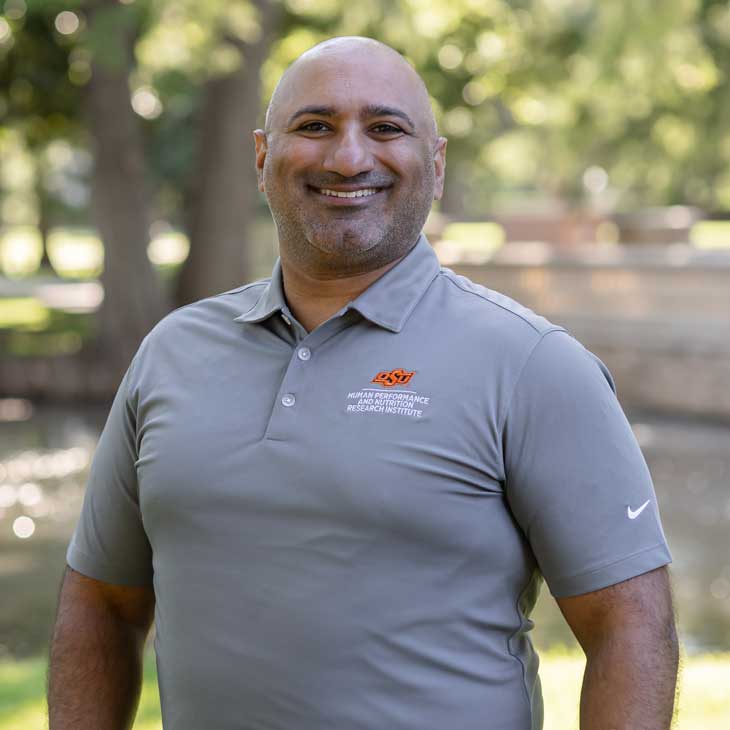
Human performance research challenges relationship between energy and fatigue
Thursday, October 10, 2024
Media Contact: Sydney Trainor | Communications and Media Relations Specialist | 405-744-9782 | sydney.trainor@okstate.edu
For the longest time, many people believed energy and fatigue were linked. If you're tired, you're not energetic, and vice versa.
However, Dr. Ali Boolani, Oklahoma State University Human Performance and Nutrition Research Institution associate director of research and strategic initiatives, has spent his career with colleagues conducting research challenging this belief.
“People think if they’re fatigued, then they’re not energetic, like heads and tails of the same coin. However, my research shows they might be two different coins and that you can be energetic and fatigued at the same time,” Boolani said.
Humans are complex. The way we feel and how our body responds to exercise, food and even how we respond to sitting desks compared to standing desks means that researchers must approach this topic from multiple angles.
This is especially evident in Boolani’s work where he finds that people can simultaneously feel energetic and fatigued — that even our biological responses are distinct.
So, what’s happening in our bodies when we feel energy or fatigue — or both?
Energy is associated with dopamine, glucose and certain biomarkers like Annexin A1 and blood oxygen levels, which help maintain stamina. Fatigue, on the other hand, is linked to serotonin and histamine, as well as inflammatory markers.
However, there are more factors to consider than biomarkers.
“We are more than our biology, and researchers must account for factors such as how we normally feel, our personality traits, and even whether we have done something before or not,” Boolani said.
A prime example is one of Boolani’s studies where individuals participated in a one-year study on the impact of group aquatic exercise on energy and fatigue. While 100% of participants reported feeling more energetic after each session, 45% reported feeling more fatigued. The individuals who reported feeling more fatigued were also less likely to show up to the following session.
Who are these individuals who reported feeling more fatigued?
“The people who reported feeling more fatigued after exercise were also the people who reported not enjoying being around other people,” Boolani said. “As researchers, we put all of them into a single intervention and did not think twice about whether they would enjoy participating in exercise with many other people around.”
These individual responses were also reported by Boolani in a study where they used caffeine as an intervention. Their work reported that while all individuals reported feeling more energetic after consuming caffeine, not all of them felt less fatigued. The most interesting results from this study were that individuals who normally feel fatigued benefited from consuming caffeine as they had faster and more accurate responses on cognitive and motor tasks.
However, individuals who normally do not report feeling fatigued reported feeling more anxious and more depressed after they consumed caffeine without having any of the cognitive or motor task benefits that people who normally felt fatigued received.
“That study just goes to show that even how you normally feel impacts how you respond to caffeine,” Boolani said.
These results were replicated in Boolani’s work using sitting desks, standing desks and walking as interventions. For example, Boolani reported that performing 90 minutes of mental tasks while sitting resulted in declines in feelings of energy, but no changes in feelings of fatigue, which was like the results of the caffeine study.
Boolani’s work suggests that the simple concept of human fatigue is multifaceted and complex. His work suggests there are many reasons for whether someone feels energetic or fatigued. This has led Boolani to try to develop AI models to predict how people feel.
Since 2017, Boolani has used cameras and wearable sensors to predict whether people feel energetic or fatigued with good accuracy. However, his work has not been able to identify how someone will respond to a certain intervention.
At OSU, Boolani plans to pursue work on developing AI models that can predict how someone will respond to a specific intervention. Using the concept of digital twins, a digital representation or model of a product, originally developed to improve the accuracy of predicting the performance of that product in various environments, Boolani hopes to create a human digital twin.
However, humans are complex and to develop a human digital twin will require multidisciplinary, outside-of-the-box thinking. Boolani feels that he is up for the challenge.
Although Boolani has dedicated his research career to identifying energy and fatigue as two distinct moods with their own distinct biological correlates, he feels that the work is just in its’ infancy.
“I am excited to learn more about the complex biology, psychology, behaviors and environment that impact whether we feel energetic, fatigued, or both. I feel that with the development of the human digital twin, we are pushing the boundaries of science!” Boolani said.
Boolani feels that if they are successful in developing a human digital twin for energy and fatigue, the work will impact other fields where humans have complex responses such as drug discovery, mental health, athletic performance and chronic disease management.
“This is my life’s work, my research agenda, and it’s just the beginning,” Boolani said.
